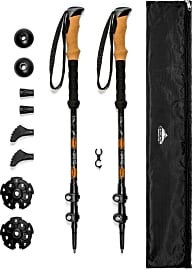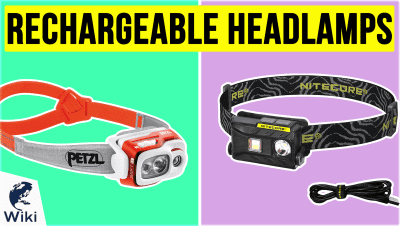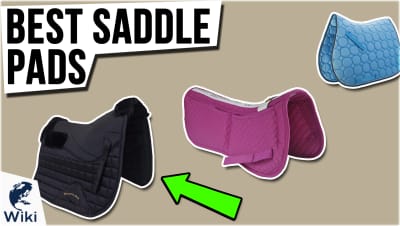The 9 Best Hiking Poles

This wiki has been updated 43 times since it was first published in March of 2015. Designed to shift some of the work from your legs to your arms while hiking, a good pair of trekking poles can reduce fatigue and minimize joint soreness over short and long treks. Even if you're just walking around the park for a few hours, a pair of these resilient and lightweight options can help keep your back and joints comfortable without adding much bulk to your gear. When users buy our independently chosen editorial selections, we may earn commissions to help fund the Wiki.
Editor's Notes
May 27, 2021:
We made a couple small but important changes this time around. The Black Diamond Trail Ergo are still the best choice that doesn't cost a fortune, and we upgraded to the Leki Makalu Lite from the same company's Corklite. They're similarly well constructed but have just a few minor improvements like ventilation holes on the handle. We also still really like the Black Diamond Distance Z, which are about as lightweight as they come. For an affordable choice, both the Cascade Mountain Tech Carbon and Cascade Mountain Tech Aluminum are still great, although they're a touch heavier than the more high-end models.
If you're really dedicated to hiking, consider the Gossamer Gear LT5 or Pacer Poles from our special Honors section. They're considerably expensive but leverage premium materials and technology for a lightweight and reliable experience.
March 30, 2020:
You don't have to spend a fortune on trekking poles, especially if you don't plan to use them much, or if you're focused on taking very good care of them. The Cascade Mountain Tech Aluminum are surprisingly effective for something so inexpensive, though they're a touch heavy for some users, and not exactly the most durable option. The Montem Ultra Strong makes up for some of that flimsiness with additional reinforcement, and if you want to shave further weight you can go with the Cascade Mountain Tech Carbon. So, while these are great options for backpackers on a budget, we'd caution against just getting the cheapest ones possible; these three have plenty of evidence supporting them as reliable. After all, if a hiking pole breaks on the trail, you still have to carry it -- but without being able to use it, which adds insult to injury.
If you're willing to spend a little more, you'll find that your options get lighter, more reliable, and more packed with helpful features. First of all, there are two main types of poles: telescoping and folding. Telescoping models like the Black Diamond Trail Ergo are a little more common and little more affordable, and their easy adjustment makes them great for elevation changes, when you might want them slightly shorter or longer than you would on flat ground. The Leki Corklite are another well-priced pair that uses high-end components. Of course, the Leki Legacy Lite are even fancier, and they're one of the few highly recommended options with an anti-shock system. This is because a minority of people really need shock absorption, but if you're among them, the Legacy Lite are the way to go.
One of the advantages of folding models like the Black Diamond Distance Z is that they tend to pack down to smaller packages, which not only makes them easier to put in or on your backpack, but also makes them much easier to stash in luggage, in case you're traveling to faraway places for your wilderness trip. The Leki Micro Vario and are every bit as lightweight and advanced, while the Black Diamond Distance FLZ are suitable for hikers well over 6 feet tall.The there's the The MSR DynaLock Ascent, which feature a combination of folding and telescoping hardware. They feature Kevlar reinforcement to ensure they remain functional during heavy use and at cold temperatures.
Special Honors
Gossamer Gear LT5 These fine folks make quite the selection of high-end gear, and especially their ultralight equipment is worth a look. In that vein, the LT5s are a seriously advanced piece of equipment, tipping the scales at barely above 10 ounces per pair. Not only that, they're every bit as durable and adjustable as any others, so if you can afford the relatively steep price tag, these should absolutely be on your list. gossamergear.com
Pacer Poles They do take a bit of getting used to, but Pacer Poles have a reputation for being some of the most comfortable walking poles around. This is due to the extremely aggressive positive angle of their handle, which means they hit the ground farther back than traditional trekking poles, so you won't have to alter your gait as much as you would with some. They're highly praised, but they're also not ideal for some backcountry hiking, so make sure to do your due diligence before buying. pacerpole.com
Health Benefits Of Hiking Poles
Many people have decided to steer clear of hiking and backpacking because of the stress it puts on the joints of the body, especially the knees.
Hiking itself is an extremely beneficial exercise method in which many people around the world engage. Walking on an uneven surface for a long period of time while hiking helps to strengthen muscles in the feet and legs that are not engaged when walking on flat ground. The hilly, uneven terrain is also a great core workout, as keeping the body stable during the climb takes more core strength than many people realize. Hiking is also a great cardiovascular exercise, and it helps to boost the metabolism and improve the blood pressure. It is also considered a safe way to build bone density.
The proper use of hiking poles takes the benefits of hiking to new levels. Many people have decided to steer clear of hiking and backpacking because of the stress it puts on the joints of the body, especially the knees. Research from the Journal of Sports Sciences has actually shown that hikers who use hiking poles show less signs of stress and deterioration to the knees, particularly when walking downhill. This is especially important for backpackers or trekkers who carry large loads over long periods of time. The researchers found that those using hiking poles had less joint movement upon impact and were also experiencing less impact force from the ground. This translates to more time spent on the trails, burning more calories and taking in more of the sites.
Hiking poles also engage the upper body in an exercise that is usually limited to the lower body and core muscle groups. Hiking has been known to strengthen the legs and core, but when using poles on the trail as well, the arms, shoulders, pectorals, and even obliques all get a workout.
Using poles during a hike may also be a great way to reduce lower back pain. Researchers found that people who engaged in uphill walking experienced less pressure and twisting in their lower backs when using hiking poles, and suggested that people with back pain use them on the trails.
The Pros And Cons Of Using Hiking Poles
There are many good things about using hiking poles, yet there are also some times when the poles can actually be more of a hindrance than a help. Understanding the differences can help you understand exactly when and how best to use them.
Some hikers say that the added movement in the upper body keeps them from feeling stiff or swollen after a long hike, as well.
Hiking poles are famously used to help reduce the impact on the joints and legs. Yet this is only a small portion of their benefits. Research from Medicine & Science in Sports & Exercise shows that people who use hiking poles can actually walk faster and still experience less force to the knees and legs than people who do not use them. This also suggests that the poles can help to increase your average speed. They do so by spreading out the energy expenditure during the hike to other areas of the body rather than just the legs. This makes for a more even workout, and less soreness in the legs, which is another benefit. Some hikers say that the added movement in the upper body keeps them from feeling stiff or swollen after a long hike, as well.
Balance is another important factor for some people, backpackers especially. Hiking for miles on uneven trails takes its toll on the body, and the equilibrium has a hard time keeping up. Add a heavy pack to the mix, and this can mean falls, scrapes, and bruises. Poles give the body two additional points of reference for keeping balance, and also give added stability and security.
The cons of using hiking poles are oddly tied to their benefits. Using the poles actually increases the body's total energy expenditure. This is great for people looking to burn more calories during a workout. If the legs are tired, poles can help reduce the load on the legs, but if the entire body is tired, using hiking poles may just make matters worse.
The other con here is that they take up space. Walking with poles takes up more space on the trail, and keeps the hands occupied when they could be doing other things. Tying them to a backpack may see them getting caught on tree branches or rocks. It is best to know if the demand for the poles is there before equipping them.
Things To Consider Before Buying A Hiking Pole
The history of walking sticks is a long one. They replaced the sword as the must-have attire for the average gentleman in the 17th and 18th centuries, and have evolved many times since then. One such evolution was the creation of the modern hiking pole. Not all poles are made equal, however. It is important to keep a few things in mind before buying any hiking pole.
If the pole is too heavy, it will feel cumbersome, and may even make the hiker more tired than walking without them.
First, it is important to consider the material of the pole. If the pole is too heavy, it will feel cumbersome, and may even make the hiker more tired than walking without them. Too flimsy a pole can result in breaks and bends if too much weight is put on them. Most modern poles are made of strong aluminum or carbon fiber, and the difference between the materials is minute at this point. Carbon fiber is lighter and technically stronger, but aluminum is more durable to wear and tear. It may be a simple matter of preference.
Another thing to consider is the grips. For light-use poles, this may not make a difference. The grip material will matter after hours on a trail, however. Many brands choose to use breathable cork or mesh material for their grips. The ability to absorb or wick away sweat from the palms is very important on long trails.
The last consideration is height adjustment. On some areas of trails, you'll need more support than on others, and being able to adjust your pole height as needed is a big benefit. From testing the depth of a river to packing snugly in a backpack, the height adjustment needs of the hiker will have to be considered before making a purchase.














